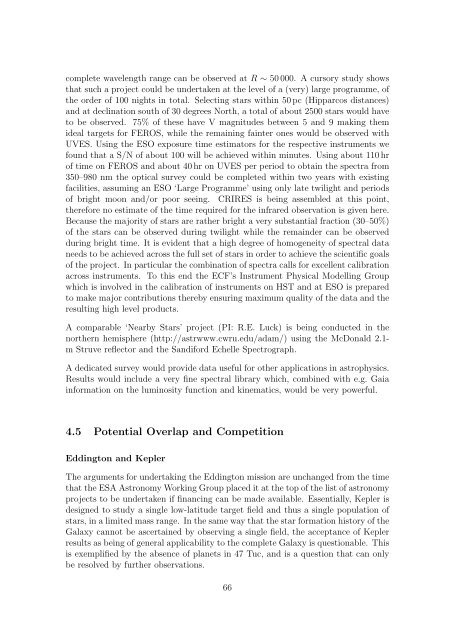Report - School of Physics
Report - School of Physics
Report - School of Physics
Create successful ePaper yourself
Turn your PDF publications into a flip-book with our unique Google optimized e-Paper software.
complete wavelength range can be observed at R ∼ 50 000. A cursory study shows<br />
that such a project could be undertaken at the level <strong>of</strong> a (very) large programme, <strong>of</strong><br />
the order <strong>of</strong> 100 nights in total. Selecting stars within 50 pc (Hipparcos distances)<br />
and at declination south <strong>of</strong> 30 degrees North, a total <strong>of</strong> about 2500 stars would have<br />
to be observed. 75% <strong>of</strong> these have V magnitudes between 5 and 9 making them<br />
ideal targets for FEROS, while the remaining fainter ones would be observed with<br />
UVES. Using the ESO exposure time estimators for the respective instruments we<br />
found that a S/N <strong>of</strong> about 100 will be achieved within minutes. Using about 110 hr<br />
<strong>of</strong> time on FEROS and about 40 hr on UVES per period to obtain the spectra from<br />
350–980 nm the optical survey could be completed within two years with existing<br />
facilities, assuming an ESO ‘Large Programme’ using only late twilight and periods<br />
<strong>of</strong> bright moon and/or poor seeing. CRIRES is being assembled at this point,<br />
therefore no estimate <strong>of</strong> the time required for the infrared observation is given here.<br />
Because the majority <strong>of</strong> stars are rather bright a very substantial fraction (30–50%)<br />
<strong>of</strong> the stars can be observed during twilight while the remainder can be observed<br />
during bright time. It is evident that a high degree <strong>of</strong> homogeneity <strong>of</strong> spectral data<br />
needs to be achieved across the full set <strong>of</strong> stars in order to achieve the scientific goals<br />
<strong>of</strong> the project. In particular the combination <strong>of</strong> spectra calls for excellent calibration<br />
across instruments. To this end the ECF’s Instrument Physical Modelling Group<br />
which is involved in the calibration <strong>of</strong> instruments on HST and at ESO is prepared<br />
to make major contributions thereby ensuring maximum quality <strong>of</strong> the data and the<br />
resulting high level products.<br />
A comparable ‘Nearby Stars’ project (PI: R.E. Luck) is being conducted in the<br />
northern hemisphere (http://astrwww.cwru.edu/adam/) using the McDonald 2.1-<br />
m Struve reflector and the Sandiford Echelle Spectrograph.<br />
A dedicated survey would provide data useful for other applications in astrophysics.<br />
Results would include a very fine spectral library which, combined with e.g. Gaia<br />
information on the luminosity function and kinematics, would be very powerful.<br />
4.5 Potential Overlap and Competition<br />
Eddington and Kepler<br />
The arguments for undertaking the Eddington mission are unchanged from the time<br />
that the ESA Astronomy Working Group placed it at the top <strong>of</strong> the list <strong>of</strong> astronomy<br />
projects to be undertaken if financing can be made available. Essentially, Kepler is<br />
designed to study a single low-latitude target field and thus a single population <strong>of</strong><br />
stars, in a limited mass range. In the same way that the star formation history <strong>of</strong> the<br />
Galaxy cannot be ascertained by observing a single field, the acceptance <strong>of</strong> Kepler<br />
results as being <strong>of</strong> general applicability to the complete Galaxy is questionable. This<br />
is exemplified by the absence <strong>of</strong> planets in 47 Tuc, and is a question that can only<br />
be resolved by further observations.<br />
66
















